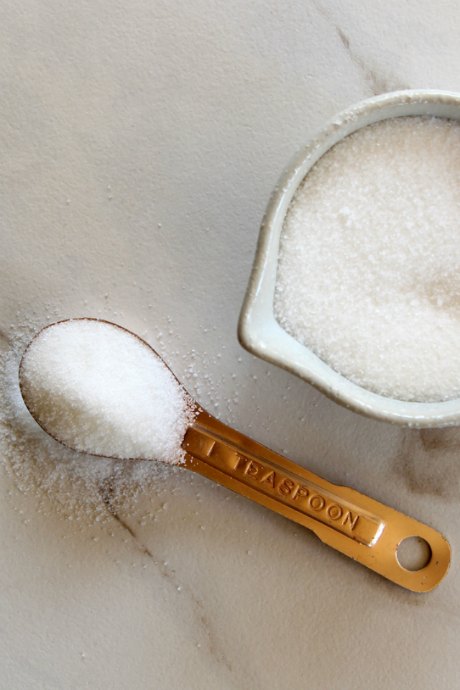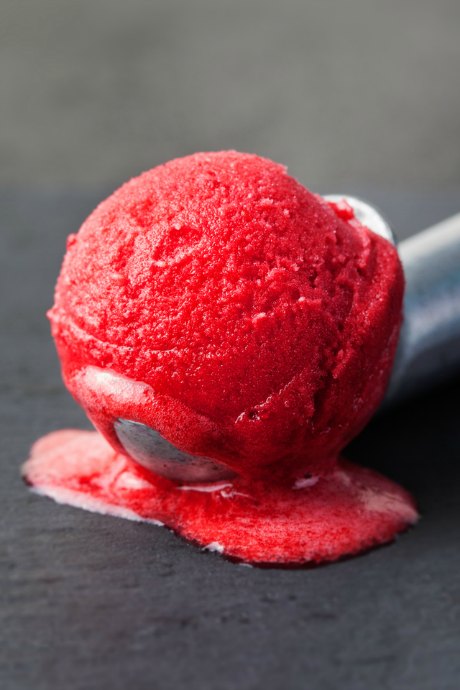Secrets to Sweet, Creamy Sorbet
Posted by Julie on May 28th 2018
Sorbet seems like it should be simple to make. It only has two ingredients: fruit and sugar. Even so, the type of fruit and the type of sugar you use introduce multiple variables to the mix. That’s why sorbet can turn out sweet and creamy one time, then hard and icy the next.
Want to hit that sweet spot more often than not? Check out the secrets of how fruit and sugar work together, and what you can do to make them get along even better.
Sorbet Secrets: Fruit Matters
Some types of fruit are perfectly suited to making sweet, creamy sorbet. For first-timers, we recommend using fruit that’s high in pectin or fiber, because those components are natural thickeners and will improve the texture. You won’t have to rely entirely on sugar concentration for texture. More on that in a bit.
What types of fruit work well in sorbet? Try berries, peaches, mangoes, pears, or bananas. These fruits require the least tinkering on your part.

Other types of fruit can present a challenge. Citrus fruit has lots of pectin in the peel, but the juice is thin and watery. Watermelon, pomegranate, and pineapple have the same problem with their juices. All of these fruits need a helping hand from sugar to make great sorbet.
Finally, because sorbet is all about the delicious taste of fruit, use your choicest pieces. Because of the role sugar plays in the texture (more on that in the next section), you can’t increase the quantity of sugar to compensate for less-than-optimal fruit.
Sorbet Secrets: Sugar Science
In sorbet, sugar isn’t used merely for sweetness. Sugar is what will make or break the texture. That means no matter how sweet your fresh fruit may be, you need sugar to turn it into sorbet. Likewise, you can’t keep adding sugar to sweeten unripe fruit, because it will affect the texture.
According to Serious Eats, the optimal sugar concentration for sorbet is 20-30%. Sugar dissolved in water lowers the freezing point of the mixture. The sweet spot of sorbet is all about adding enough sugar to prevent it from freezing solid, while not adding so much sugar that it won’t solidify at all.
There are a few ways to achieve this optimal sugar concentration. First, you can use a refractometer. We found one for $30, which is a lot less than many other items in your kitchen. Plus, a refractometer also comes in handy when making jams, jellies, sauces, and syrups.
You can also gauge sugar concentration using this simple test we found on The Kitchn: Wash and dry a large egg, then place it in your sorbet mixture. The egg should float and expose the tip of the shell. You want the diameter of the exposed shell to be the size of a nickel. If it’s larger than a nickel, your sugar concentration is too high; add some water or fruit juice. If it’s smaller than a nickel, your sugar concentration is too low; add some sugar.
Finally, you can follow the ratio of one cup of sugar to four cups of fruit puree. This strategy will ensure you’re within that 20-30% range: The quantity of added sugar is 20% of the total sorbet volume, plus the sugar naturally occurring in the fruit. Be sure to strain your fruit puree to eliminate seeds.
Sorbet Secrets: Not All Sugar Is Created Equal
You can use granulated sugar, simple syrup, or corn syrup in your sorbet. Each one behaves a little differently, and your choice should depend on the fruit you’re using.
The 1:4 ratio described above uses granulated sugar. It works well with the types of fruit that are a sure thing in sorbet. If you want to double-check your sugar concentration, use the egg test or whip out your refractometer.

Fruits on the tart side or the watery side (or both) need a little extra attention. Instead of using granulated sugar, Serious Eats recommends substituting corn syrup. The viscosity of corn syrup will help offset thin, watery fruit purees to make your finished sorbet creamier.
The problem with using corn syrup is that the 1:4 ratio no longer works. That is, don’t try adding one cup of corn syrup to four cups of fruit puree. Start with recipes that call specifically for corn syrup, like this lemon sorbet recipe. Then you can experiment with the proportions of granulated sugar and corn syrup in combination with different types of fruit. If you reach this point, you’ll probably want to spring for that refractometer to help reduce your error rate. (Go on, it’s only $30.)
Sorbet Secrets: Chill and Churn (and Chill Again)
You’ve used only the freshest fruit you could find. You’ve tweaked the type and amount of sugar you added. You’ve gauged the sugar concentration of your mixture, either using an egg or a refractometer. Now it’s time to chill and churn, and then chill once more.
If you’ve made ice cream or sorbet at home before, you already know you need to chill the mixture before churning it in an ice cream maker. However, because sorbet can be so finicky, we recommend trying this technique from Cooks Illustrated: Before churning your mixture, pour a cup of it into a separate, freezer-safe container, and put it in the freezer. Put the rest of your mixture into the refrigerator. Once the portion in the freezer is solid, add it to the chilled portion and churn the entire mixture.
The reason for this technique concerns the formation of ice crystals. Cooks Illustrated explains the details.
Because the small portion freezes much more rapidly than if we tried to freeze the whole batch, there isn’t enough time for large crystals to grow, and instead very small ice crystals form. Then, when we add this frozen mix back to the rest of the base, the tiny crystals trigger a chain reaction that very rapidly form equally small crystals in the bigger mix.
Part of what can prevent sorbet from being creamy is the formation of large ice crystals. This technique helps keep all the crystals small, which results in softer, creamier sorbet.

Finally, Cooks Illustrated also weighed in on the matter of churning time. In fact, the key to timing is not to watch the clock, but the sorbet itself. The color will begin to lighten as it absorbs air, which is your clue that your sorbet is finished. However, Cooks Illustrated estimates churning time to be in the range of 18-20 minutes. Start peeking at at the 15-minute mark.
We hope these tips we’ve gathered will help you churn up your sweetest, creamiest batch of sorbet yet.

